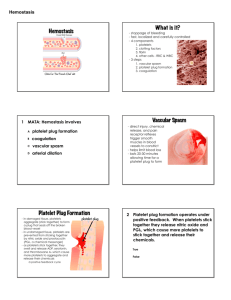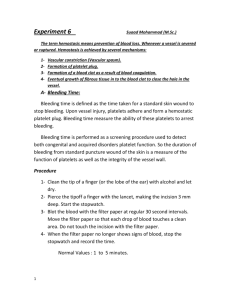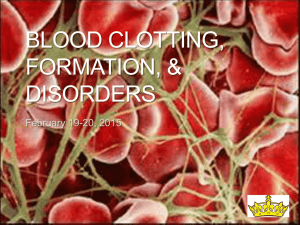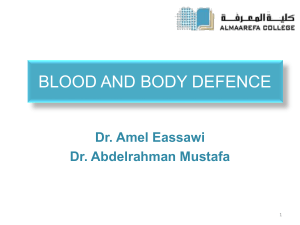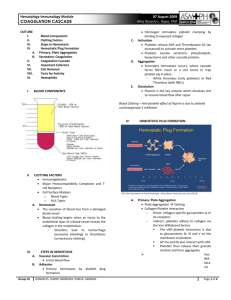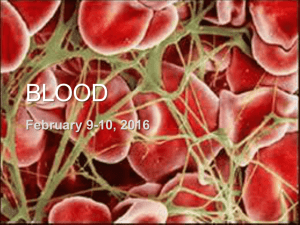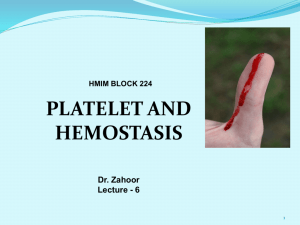activated
advertisement
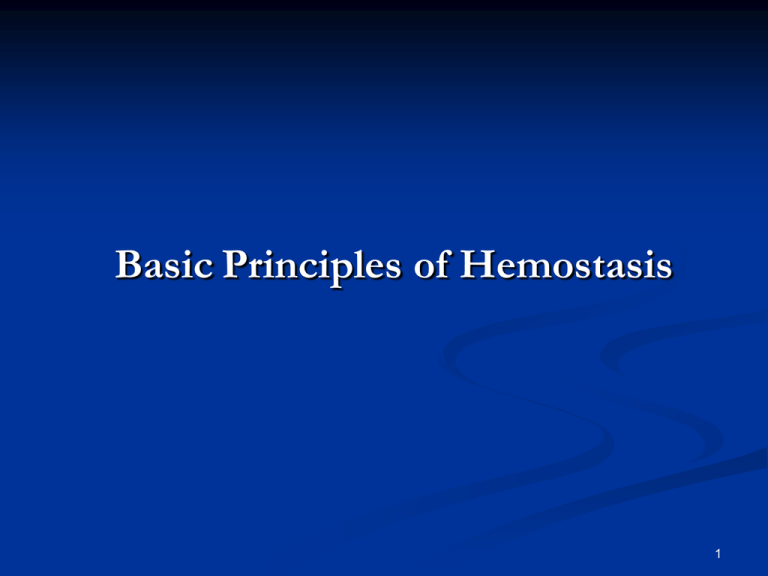
Basic Principles of Hemostasis 1 Objectives: Describe the 4 steps of hemostasis Describe platelets, their normal count, development, and functions. Describe the process of coagulation & the role of Vit K in it Define normal coagulation time List the natural anti-coagulants present in blood Define hemophilia and list possible symptoms of hemophilia Explain normal bleeding time and define Purpura 2 Steps of Hemostasis 1. Vascular spasm (vasoconstriction) 2. Platelet plug formation 3. Clot formation (blood clotting) 4. Clot retraction 3 Platelets (Thrombocytes) Count 150,000-400, 000 /μL Origin: megakaryocytes in bone marrow develop under influence of “Thrombopoeitin” Disc shape- with vesicles 2-4 μ in size No nucleus Platelets Residues of ER, Golgi apparatus Mitochondria Enzyme systems Contain granules which secrete chemicals: i. Serotonin; ii. endothelial growth factor; iii. Prostaglandins; iv. phospsholipids (membrane) v. Fibrin stabilizing factor vi. Platelet Derived Growth factor Natural destruction by macrophages in spleen 4 Functions of platelets: Help in hemostasis (stoppage of bleeding) by 1. producing vasoconstriction 2. becoming sticky (activated) to form a platelet plug to close small holes in blood vessels 3. initiate coagulation Clinical implications Low dose Aspirin reduces platelet adhesiveness: Rationale for use in “blood thinning” Low platelet count (< 50,000/μL) causes bleeding disorder Simple investigation: Bleeding time measurement by finger prick. Normal bleeding time 3-6 minutes Disease when platelet count is low: Thrombocytopenic purpura5 Vascular spasm Contraction of vascular smooth muscle because of i. muscle damage; ii. serotonin from platelets Platelet plug formation 1. Platelet adhesion to damaged endothelium 2. Platelet release reaction: ADP: increase platelet adhesiveness (stickiness) 3. Serotonin & TXA2 : vasoconstriction 4. Platelets stick to one another to form a plug: Adhesion which is good enough to stop a small puncture from bleeding (Prostacyclin from endothelium opposes ( )يعارضstickiness) 6 Blood coagulation: factors involved 7 Principles of Hemostasis Blood coagulation Vit K Prothrombin activator PROTHROMBINASE) (Factor Xa + Ca++ + Phospholipid + Factor V) -Source: dietary, large intestine bacteria -Fat soluble; -Synthesis of prothrombin, factors VII, IX, X, Protein C Prothombin thrombin Thrombin: Accelerates prothrombinase formation fibrinogen fibrin F XIII Serum (straw yellow in colour) = blood – clotting factors Clot retraction + RBC = clot 8 (a) Extrinsic pathway (b) Intrinsic pathway Tissue trauma Blood trauma Damaged endothelial cells expose collagen fibers Tissue factor (TF) Damaged platelets Activated XII Activated platelets Ca2+ Ca2+ + Platelet phospholipids Activated X Activated X V 1 V Ca2+ Ca2+ + PROTHROMBINASE (c) Common pathway Ca2+ Prothrombin (II) THROMBIN Ca2+ Fibrinogen (I) Loose fibrin threads 2 XIII Activated XIII STRENGTHENED FIBRIN THREADS 3 9 Prothrombinase (Prothrombin activator) 10 Breakup/limitation of clot: Fibrinolysis Clot contains Plasminogen Plasmin activate Thrombin, Active Factor XII Tissue –plasminogen activator (pTA) clot lysis (clot breaks up Prostacyclin Inhibits platelet adhesiveness 11 Natural anticoagulants: A. Endothelial surface factors 1. Smoothness of endothelial wall: so has glycocalyx which repels clotting factors 2. Protein C :inactivates factors V and VIII 3. Thrombomodulin- a protein bound to endothelium -combines with thrombin to reduce clotting. B. Anticoagulants present in the blood which remove THROMBIN 1. Fibrin itself 2. Antithrombin III -antithrombin (α globulin) + heparin -removes activated factors XII, XI, X -removes thrombin C. Anticoagulants may be used In patients: i. Heparin ii. Vit K antagonists 4. This combination also activates Protein C Outside the body: i. Heparin ii. Calcium antagonists 12 Normal coagulation time: 3-7 minutes (finger Clinical implications Coagulation disorders : prick method) i. not enough coagulations factors--? (Hemophilia (factor VIII deficiency) transmitted by female to males. Only males suffer) ii. Not enough Vit K 13 Summary Steps of hemostasis Platelets and their role in hemostasis Normal bleeding time and its abnormality Coagulation factors The clotting cascade and formation of prothrombinase Natural anti-coagulation Anticoagulation in treatment Normal clotting time and abnormalities 14



